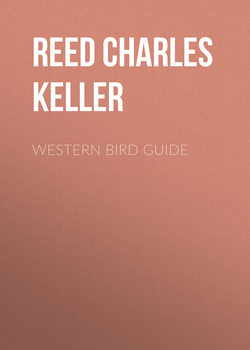Читать книгу Western Bird Guide - Reed Charles Keller - Страница 53
FULMARS AND SHEARWATERS
BITTERN – Family Herodii
Оглавление190. Botaurus lentiginosus. 28 inches
These are birds of the bogs and marshes, and will keep concealed so closely that one may pass within a few feet of them and they not take flight. They are known by a variety of names, nearly all of which have reference to their “booming” sound while in the bogs. The most common name given them being “Stake Driver” and again “Thunder Pumper.” They are much variegated with brown and yellowish brown; adults with a long, broad black stripe on either side of the white throat; eye is yellow; bill and legs, greenish yellow.
Nest.– They build in swamps or marshy places, placing their nest usually in a tussock of grass on some bog surrounded by water. They lay from three to five brownish colored eggs (1.95 × 1.50).
GREAT BLUE HERON
194. Ardea herodias herodias. 48 inches
This handsome Heron in general color in the adult stage is bluish gray, relieved by a black crest, and black primaries and patches on the sides and a white crown. Young birds are much duller colored and lack the crest of the old birds. It takes several years for them to obtain their perfect plumage. In the South they breed in large colonies, often in company with many other species.
Nest.– Is usually built of sticks, making a rude platform in the trees near swamps or wet woods. In some localities as many as 40 nests have been found in a single tree. Three to five eggs of a greenish blue color (2.50 × 1.50).
Range.– North America except the extreme northern part, breeds from British Columbia to southern Lower California.
GREEN HERON
201. Butorides virescens virescens. 17 inches
This is the smallest of our Herons, and is well known all over the country. In most sections of the country they will be found nesting, one of two pairs together, along the border of some swamp or stream; 3 to 5 pale greenish blue eggs (1.45 × 1.10).
